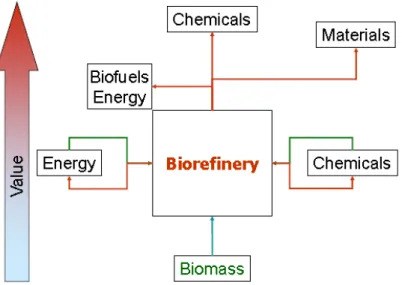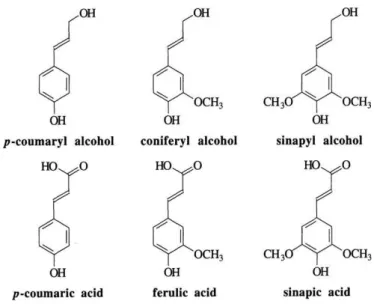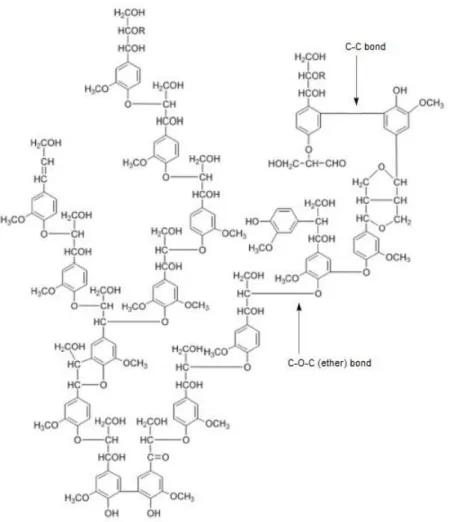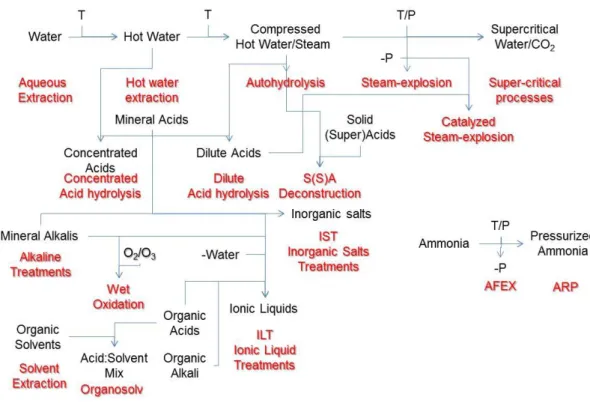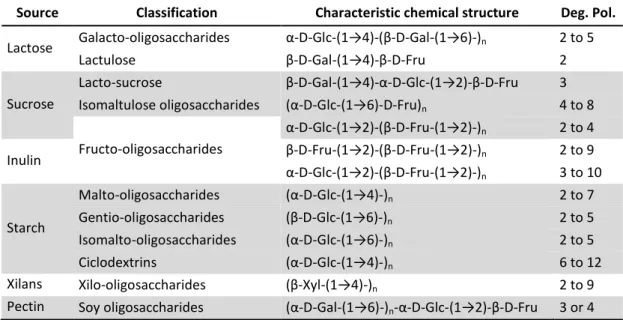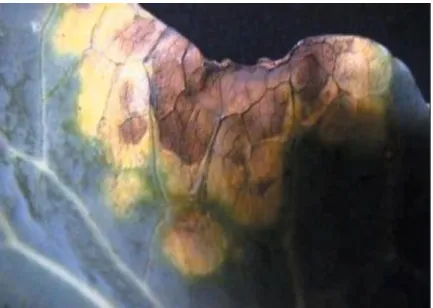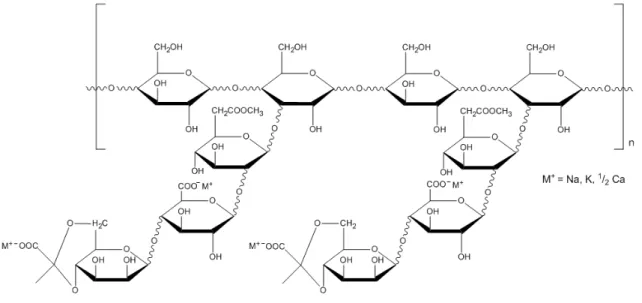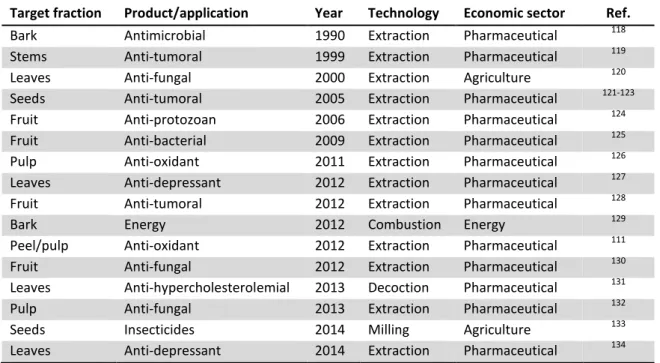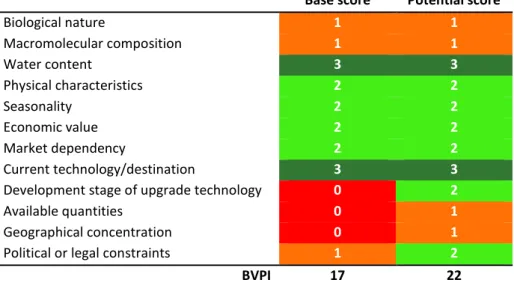DM
TD
January | 2016
Pedro Miguel Sena da Costa Branco
DOCTORATE IN CHEMISTRY - ORGANIC CHEMISTRY
Integrated valorization
SUPERVISOR
Paula Cristina Machado Ferreira Castilho
CO-SUPERVISOR
Luís Jorge Abreu Chorão de Quelhas Duarte
Pedro Miguel Sena da Costa Branco
DOCTORATE IN CHEMISTRY - ORGANIC CHEMISTRYof
Annona cherimola
Mill. seeds
«Eu sou aquele oculto e grande Cabo
A quem chamais vós outros Tormentório,
Que nunca a Ptolomeu, Pompónio, Estrabo,
Plínio e quantos passaram fui notório.»
Pedro Miguel Sena da Costa Branco
vii
Acknowledgements
Firstly, I must thank my supervisors, Paula and Luís, for the outstanding
guidance and for maintaining their confidence in me throughout this
journey. You were true mentors, both professionally and personally.
I would also like to thank to the CQM and UB coordinators, Prof. João
Rodrigues and Dr. Francisco Gírio, respectively, for conceding me the
opportunity of developing this work at CQM and UB facilities.
I am especially grateful to AGRIPÉROLA – Cooperativa Agrícola, C.R.L. and J. Faria & Filhos Lda. for kindly providing the annona seeds used in
this work.
My acknowledgements are also directed to all the CQM and UB research
and technical staff. Your availability to help me whenever I needed to, as
well as your good advices, was fundamental.
So many grant holders and trainees crossed my path during this period that
I prefer not to mention any names, because I am afraid to forget someone.
To all of you my thanks! However, I must specially thank to Sandra and
João (you both made me feel at home when I was away from it and I hope
you to be very happy in your journey together) and to Ivone (you made me
open my eyes and always pushed me into pursuing my dreams – I really hope you can pursue yours, you deserve it!). I also must thank Patrícia and
Talita, whose journey also ended recently, for the patience to put up with
me in our office.
Thank you Marlene, for helping me to restore my self-confidence and the
will to run to the end of the tunnel.
Finally, and last but not least (no way!), I’m especially thankful to my family and friends, namely my parents, which were always my support.
Pedro Miguel Sena da Costa Branco
ix
Resumo
Os resíduos agrícolas e das indústrias agro-alimentares são normalmente
um problema não só ambiental, mas também económico. Assim, é necessária
uma mudança de paradigma, que passa pela assumpção destes como
matérias-primas da biorrefinaria. Neste trabalho utilizaram-se sementes de
anona (Annona cherimola Mill.), ricas em lípidos (ca. 30%) e material
lenhocelulósico, como exemplo de um resíduo actualmente sem qualquer
valorização.
A fracção lipídica foi extraída com solvente, tendo o rendimento variado
entre 13 e 28 g óleo/100 g biomassa, consoante o método e tempo de
extracção e a pureza do solvente. Este óleo foi convertido em biodiesel (por
transesterificação alcalina), tendo-se obtido 76 g FAME/100 g óleo. Este
biodiesel demonstrou ser passível de incorporação em combustíveis
comerciais, de acordo com os parâmetros da norma EN14214.
A restante fracção lenhocelulósica foi sujeita a dois processos de
fraccionamento alternativos para recuperação selectiva da hemicelulose, por
forma a obterem-se diferentes produtos. Para ambos os processos foram
desenvolvidos modelos matemáticos empíricos, tendo em vista a sua
utilização em estudos de scale-up.
Por autohidrólise obtiveram-se maioritariamente oligossacáridos (10 gL-1)
cujas propriedades sustentam potenciais aplicações alimentares e/ou
farmacêuticas. O resíduo sólido resultante foi posteriormente sacarificado
enzimaticamente, tendo-se obtido um rendimento de sacarificação máximo
de 83%.
No hidrolisado obtido com ácido diluído destacam-se os monossacáridos,
maioritariamente xilose (26 gL-1), glucose (10 gL-1) e arabinose (3 gL-1), e um
baixo teor de inibidores do crescimento microbiano. Este hidrolisado
mostrou ser um meio de cultura apropriado para bactérias e consórcios
Ph.D. IN CHEMISTRY – ORGANIC CHEMISTRY x
máxima de monossacáridos em xantano foi de 0,87 g/g e a produtividade
máxima de kefirano foi de 0.07 g.(Lh)-1.
Este trabalho demonstra a exequibilidade técnica da utilização das
sementes de anona como um resíduo passível de ser valorizado, abrindo
novas perspectivas para a valorização deste tipo de materiais no âmbito da
biorrefinaria.
Palavras chave
Biodiesel; Biorrefinaria; Exopolissacáridos; Fraccionamento; Materiais
Pedro Miguel Sena da Costa Branco
xiii
Abstract
Agricultural and agro-industrial residues are often considered both an
environmental and an economical problem. Therefore, a paradigm shift is
needed, assuming residues as biorefinery feedstocks. In this work cherimoya
(Annona cherimola Mill.) seeds, which are lipid-rich (ca. 30%) and have a
significant lignocellulosic fraction, were used as an example of a residue
without any current valorization.
Firstly, the lipid fraction was obtained by solvent extraction. Extraction
yield varied from 13% to 28%, according to the extraction method and time,
and solvent purity. This oil was converted into biodiesel (by base-catalyzed
transesterification), yielding 76 g FAME/100 g oil. The obtained biodiesel is
likely to be incorporated in the commercial chain, according to the EN14214
standard.
The remaining lignocellulosic fraction was subjected to two alternative
fractionation processes for the selective recovery of hemicellulose, aiming
different products. Empirical mathematical models were developed for both
processes, aiming future scale-up.
Autohydrolysis rendered essentially oligosaccharides (10 gL-1) with
properties indicating potential food/feed/pharmacological applications. The
remaining solid was enzymatically saccharified, reaching a saccharification
yield of 83%.
The hydrolyzate obtained by dilute acid hydrolysis contained mostly
monosaccharides, mainly xylose (26 gL-1), glucose (10 gL-1) and arabinose (3
gL-1), and had low content of microbial growth inhibitors. This hydrolyzate
has proven to be appropriate to be used as culture media for
exopolisaccharide production, using bacteria or microbial consortia. The
maximum conversion of monosaccharides into xanthan gum was 0.87 g/g
Ph.D. IN CHEMISTRY – ORGANIC CHEMISTRY xiv
This work shows the technical feasibility of using cherimoya seeds, and
materials as such, as potential feedstocks, opening new perspectives for
upgrading them in the biorefinery framework.
Keywords
Pedro Miguel Sena da Costa Branco
xvii
Contents
Acknowledgements ... vii
Resumo ... ix
Palavras chave ...x
Abstract ... xiii
Keywords ... xiv
Contents ... xvii
List of tables ... xxiii
List of figures ... xxvii
List of publications ... xxxi
Notation ... xxxv
Greek Symbols ... xxxviii
Scope and outline of the thesis ... xli CHAPTER 1 GENERAL INTRODUCTION ... 1
Summary ... 3
1.1 The Biorefinery ... 5
1.1.1 The Biorefinery concept ... 5
1.1.2 Biorefinery platforms... 6
1.1.3 Biorefineries and islands' sustainability... 7
1.2 Biorefinery feedstocks ... 8
1.2.1 Biomass oil sources for biodiesel production ... 8
1.2.1.1 Vegetable oil extraction procedures ... 8
1.2.1.2 Biodiesel production processes ... 9
1.2.2 The lignocellulosic materials ... 11
1.2.2.1 Composition of lignocellulosic materials ... 11
1.2.2.1.1 Cellulose ... 12
1.2.2.1.2 Hemicelluloses ... 13
1.2.2.1.3 Lignin ... 14
1.2.2.1.4 Compounds of low molecular weight/extractives ... 15
1.3 Biochemical platform processes ... 16
1.3.1 Acid hydrolysis ... 17
1.3.1.1 Concentrated-acid hydrolysis ... 18
1.3.1.2 Dilute-acid hydrolysis ... 18
1.3.2 Autohydrolysis ... 19
1.4 Biorefinery products... 20
1.4.1 Oligosaccharides as valuable compounds ... 22
1.4.1.1 Oligosaccharides production processes ... 23
1.4.2 Microbial polysaccharides as biorefinery products ... 24
Ph.D. IN CHEMISTRY – ORGANIC CHEMISTRY xviii
1.4.2.2 Microbial exopolysaccharides production processes ... 26 1.4.2.3 Xanthomonas campestris ... 27 1.4.2.4 Xanthan production ... 28 1.4.2.5 Kefir and Kefiran ... 30
1.5 Annona cherimola Mill. ... 32 1.5.1 Cherimoya seeds’ BVPI ... 34
1.6 References ... 36
CHAPTER 2 CHARACTERIZATION OF ANNONA CHERIMOLA MILL. SEED OIL FROM MADEIRA ISLAND – A POSSIBLE BIODIESEL FEEDSTOCK ... 55
Summary ... 57
2.1 Introduction ... 59
2.2 Methods ... 60
2.2.1 Materials ... 60
2.2.2 Oil extraction and characterization ... 61
2.2.2.1 Extraction procedures ... 61 2.2.2.2 Determination of the FFA content by titrimetry ... 61 2.2.2.3 Oil resistance to oxidation ... 61 2.2.2.4 Determination of FA composition ... 62 2.2.2.5 FAME analysis ... 62 2.2.2.6 Evaluation of the lipidic composition by 13C-NMR ... 62 2.2.2.7 Determination of TAG structure by HPLC-APCI-MS ... 63
2.2.3 Biodiesel production and characterization ... 63
2.2.3.1 Biodiesel production procedure ... 63 2.2.3.2 Biodiesel characteristics ... 64
2.3 Results and discussion ... 64
2.3.1 Oil characterization ... 65
2.3.2 FA composition ... 67
2.3.3 13C-NMR analysis ... 67 2.3.4 TAG structure... 68
2.3.5 Conversion of the oil into biodiesel and its properties ... 71
2.4 Conclusions ... 72
2.5 References ... 73
CHAPTER 3 OPTIMIZATION OF OIL EXTRACTION AND PRODUCTS CHARACTERIZATION .... 79
Summary ... 81
3.1 Introduction ... 83
3.2 Methods ... 84
3.2.1 Materials ... 84
3.2.2 Oil extraction procedures ... 85
3.2.2.1 ASE ... 85 3.2.2.2 Soxhlet extraction ... 85 3.2.2.3 RTE ... 85
Pedro Miguel Sena da Costa Branco
xix
3.2.3.1 Cake analysis ... 86 3.2.3.1.1 Ash determination ... 86 3.2.3.1.2 Quantitative acid hydrolysis ... 86 3.2.3.1.3 Quantification of structural polysaccharides and lignin in solid samples ... 87 3.2.3.1.4 Protein content ... 89 3.2.3.2 Oil composition ... 89
3.3 Results and discussion ... 90
3.3.1 Soxhlet extraction vs RTE vs ASE ... 90
3.3.2 Commercial vs analytical grade hexane ... 91
3.3.3 Solid residues analysis ... 92
3.3.4 Oil composition ... 92
3.4 Conclusions ... 92
3.5 References ... 93
CHAPTER 4 AUTOHYDROLYSIS OF ANNONA CHERIMOLA MILL. SEEDS: OPTIMIZATION, MODELING AND PRODUCTS CHARACTERIZATION ... 97
Summary ... 99
4.1 Introduction ... 101
4.2 Methods ... 103
4.2.1 Materials ... 103
4.2.2 Autohydrolysis treatments ... 104
4.2.3 Scanning electron microscopy ... 105
4.2.4 Mathematical modeling ... 105
4.2.5 Analytical procedures ... 105
4.2.6 Stability of the liquid fraction and OS ... 106
4.2.7 Enzymatic digestibility of the remaining solid ... 107
4.3 Results and discussion ... 108
4.3.1 Autohydrolysis liquors and solid residues composition ... 108
4.3.2 Mathematical modeling of the autohydrolysis process ... 110
4.3.3 Hydrolyzate’s shelf life evaluation ... 115
4.3.4 OS’ stability ... 115
4.3.5 Enzymatic digestibility of the solid residues ... 117
4.4 Conclusions ... 119
4.5 References ... 120
CHAPTER 5 OPTIMIZATION AND MATHEMATICAL MODELING OF CHERIMOYA SEEDS’ DILUTE ACID HYDROLYSIS FOR THE PRODUCTION OF HEMICELLULOSIC HYDROLYZATES .... 127
Summary ... 129
5.1 Introduction ... 131
5.2 Methods ... 132
5.2.1 Materials ... 132
Ph.D. IN CHEMISTRY – ORGANIC CHEMISTRY xx
5.2.3 Dilute acid hydrolysis ... 134
5.2.4 Analytical Methods ... 135
5.3 Results and discussion ... 135
5.3.1 Composition of hydrolysis liquor ... 135
5.3.2 Dilute Acid Hydrolysis Modeling ... 137
5.3.3 Numerical optimization ... 140
5.3.4 Solid residue characterization ... 140
5.4 Conclusions ... 144
5.5 References ... 144
CHAPTER 6 PRODUCTION OF XANTHAN GUM USING CHERIMOYA SEEDS’ HEMICELLULOSIC HYDROLYZATE AS A CULTURE MEDIUM ... 149
Summary ... 151
6.1 Introduction ... 153
6.2 Methods ... 153
6.2.1 Materials ... 153
6.2.2 Dilute acid-hydrolysis ... 154
6.2.3 Medium preparation ... 155
6.2.3.1 Pre-inoculum medium ... 155 6.2.3.2 Xanthan gum production medium ... 155
6.2.4 Xanthomonas campestris fermentation ... 155
6.2.5 Sampling ... 156
6.2.6 Analytical methods ... 156
6.2.6.1 Calculations ... 156
6.2.7 Xanthan gum quantitation... 157
6.3 Results ... 157
6.3.1 Hydrolyzate composition ... 157
6.3.2 Xanthomonas campestris fermentation profiles ... 158
6.3.3 Xanthan gum production ... 161
6.4 Conclusions ... 162
6.5 References ... 163
CHAPTER 7 CHERIMOYA SEEDS HEMICELLULOSIC HYDROLYZATE AS A CULTURE MEDIUM FOR THE PRODUCTION OF KEFIR GRAINS ... 167
Summary ... 169
7.1 Introduction ... 171
7.2 Methods ... 172
7.2.1 Materials ... 172
7.2.2 Dilute acid-hydrolysis ... 173
7.2.3 Media preparation ... 173
Pedro Miguel Sena da Costa Branco
xxi
7.2.3.2 Supplemented medium ... 173 7.2.3.3 Chemically defined medium (CDM) ... 173
7.2.4 Kefir fermentation ... 174
7.2.5 Sampling ... 174
7.2.6 Analytical methods ... 174
7.2.6.1 Calculations ... 175
7.3 Results ... 175
7.3.1 Hydrolyzate composition ... 175
7.3.2 Kefiran production ... 176
7.4 Conclusions ... 178
7.5 References ... 178
CHAPTER 8 FINAL CONSIDERATIONS AND PROSPECTS ... 183
Pedro Miguel Sena da Costa Branco
xxiii
List of tables
Table 1-1 Traditional division of the biorefinery into four platforms and the main processes
used in each of them ... 7
Table 1-2 Main groups of OS, their structure and DP ... 23
Table 1-3 Main bacterial polysaccharides ... 26
Table 1-4 Potential applications for A. cherimola ... 34 Table 1-5 Main differences reported for the fruits of the four Madeira Island cultivars of A. cherimola ... 34 Table 1-6 BVPI scores for cherimoya seeds in Madeira Island (base score) and globally
(potential) ... 35
Table 2-1 FA composition of cherimoya seed oil and other vegetable oils used as biodiesel
sources ... 67
Table 2-2 Molecular species identification of the TAG of cherimoya seed oil... 70
Table 2-3 Properties of the biodiesel produced ... 71
Table 3-1 Percentages of the major fatty acids (FA) present in the selected oils... 92
Table 4-1 Composition of the buffers used for the evaluation ... 106
Table 4-2 Seed cake composition, and solid yield and solid residues composition obtained in
the autohydrolysis assays of cherimoya seeds ... 109
Table 4-3 Determined parameters for the proposed model for the autohydrolysis of cherimoya
seeds – pre-exponential factor (ln An) and activation energies (Ean) ... 113
Table 4-4 Evolution of the OS’ concentrations during the shelf life test ... 115
Table 5-1 Codified matrix for the Doehlert experimental design for two variables and the
corresponding experimental conditions ... 133
Table 5-2 Monosaccharides and by-products concentration obtained for the different trials
(A-G) and control conditions (Z) ... 136
Table 5-3 Regression coefficients estimates for the polynomial model, for the different
responses analyzed ... 139
Table 5-4 Regression coefficients estimates for the polynomial model, for the different
responses obtained on solid residue analysis ... 143
Table 6-1 Composition of the hydrolyzate obtained in optimized conditions ... 158
Table 6-2 Specific growth rates (x), X. campestris production rate (Qx) and X. campestris yield
Ph.D. IN CHEMISTRY – ORGANIC CHEMISTRY xxiv
Table 6-3 Xanthan gum maximum concentration ([Xant]max), productivity (QXant) and yield (YXant)
Pedro Miguel Sena da Costa Branco
xxvii
List of figures
Figure 1-1 The biorefinery concept ... 5
Figure 1-2 Simplified transesterification reaction ... 10
Figure 1-3 Composition of lignocellulosic materials ... 11
Figure 1-4 The β-linked glucopyranoside residues and the inter- and intra-molecular bonding of
cellulose ... 13
Figure 1-5 Chemical structure of lignin precursors ... 14
Figure 1-6 Proposed structural model for spruce lignin ... 15
Figure 1-7 Different biomass fractionation processes and their associations ... 17
Figure 1-8 Polysaccharide hydrolysis mechanism ... 21
Figure 1-9 Native structure of gellan ... 26
Figure 1-10 X. campestris pv. campestris caused black rot in cabbage leaf ... 28 Figure 1-11 Structure of extracellular polysaccharide of X. campestris ... 29 Figure 1-12 Milk Kefir “grains” ... 31
Figure 1-13 Putative structure of Kefiran ... 31
Figure 2-1 FT-IR spectra of a) freshly obtained oil and after b) 8 days and c) 12 days under
oxidative conditions ... 65
Figure 2-2 13C-NMR spectrum (100.61 MHz) of a the carbonyl carbons and b the glycerol
carbons of cherimoya seed oil ... 68
Figure 2-3 Reconstructed ion chromatogram of TAG from cherimoya seed oil achieved by
HPLC–APCI–MS ... 69
Figure 3-1 Extraction yields obtained for the three methods tested ... 91
Figure 3-2 Comparison between commercial and pro analysis hexane for a) RTE and b) Soxhlet
extractions ... 92
Figure 4-1 Apparatus used for the autohydrolysis treatments ... 104
Figure 4-2 Soluble products’ concentrations in the hydrolyzates as a function of log RO ... 108
Figure 4-3 SEM photomicrographs a) before and b, c and d) after autohydrolysis at
190 ºC ... 111
Figure 4-4 Pathway of AcMs’ hemicellulose conversion during the autohydrolysis
process ... 111
Figure 4-5 Heating profiles of the autohydrolysis treatments ... 112
Figure 4-6 Experimental and calculated time courses for the non-isothermal autohydrolysis of
Ph.D. IN CHEMISTRY – ORGANIC CHEMISTRY xxviii
Figure 4-7 Stability profiles of the produced OS at 100 ºC ... 116
Figure 4-8 Stability of the produced OS in conditions similar to the human digestion
process ... 117
Figure 4-9 Enzymatic digestibility of treated cherimoya seeds in terms of a glucose relative
concentration and b glucose relative yield ... 118
Figure 4-10 SEM photomicrographs after autohydrolysis at a) 190 ºC and b) 230 ºC ... 119
Figure 5-1 Contour plot for the concentration of total sugars minus total inhibitors (TS-TI) in
relation to acid concentration (X1) and reaction time (X2) ... 141
Figure 5-2 Effect of the combined severity parameter on the solid yields and composition of
the solid residues after dilute acid hydrolysis ... 142
Figure 6-1 Monosaccharide assimilation pattern for the a) 193F, b) 302F, c) 304F and d) 353F
strains of X. campestris ... 159 Figure 6-2 Acetic acid profiles during the fermentation ... 160
Figure 6-3 Growth profiles of the four tested strains of X. campestris... 160 Figure 7-1 Growth profiles of Kefirgrown in cherimoya seed hemicellulosic hydrolyzates and
CDM ... 177
Figure 7-2 Monosaccharide assimilation pattern for Kefir grown in non-supplemented
cherimoya seed hemicellulosic hydrolysate ... 177
Pedro Miguel Sena da Costa Branco
xxxi
List of publications
This thesis is based on the following publications and communications:
Papers in international scientific periodicals with referees
Pedro Costa Branco, Paula C. Castilho, Maria Fernanda Rosa, Juan
Ferreira, Characterization of Annona cherimola Mill. Seed Oil from Madeira
Island: a Possible Biodiesel Feedstock, Journal of the American Oil
Chemists’ Society, Volume 87, pp. 429-436, April 2010,
DOI 10.1007/s11746-009-1513-1
P.C. Branco, A.M. Dionísio, I. Torrado, F. Carvalheiro, P.C. Castilho, L.C.
Duarte, Autohydrolysis of Annona cherimola Mill. seeds: Optimization,
modeling and products characterization, Biochemical Engineering
Journal, Volume 104, pp 2-9, December 2015,
DOI 10.1016/j.bej.2015.06.006
P.C. Branco, I. Torrado, F. Carvalheiro, P.C. Castilho, L.C. Duarte,
Optimization and mathematical modelling of cherimoya seeds dilute acid
hydrolysis for the production of hemicellulosic hydrolyzates, (submitted)
Papers in peer reviewed conference proceedings
P.C. Branco, P.C. Castilho, J. Ferreira, Extraction and Composition of
Annona’s Seed Oil and Its Potential Use for the Production of Biodiesel,
Proceedings of Bioenergy: Challenges and Opportunities –
International Conference and Exhibition on Bioenergy, Volume II,
pp. 27-32, Guimarães, Portugal, April 2008
Branco, P.C., Torrado, I., Klydjeneiro, Z., Pereira, C., Bogel-Lukasik, E.,
Carvalheiro, F., Castilho, P.C., Duarte, L.C., Cherimoya seeds hemicellulosic
Ph.D. IN CHEMISTRY – ORGANIC CHEMISTRY xxxii
of the 1st Iberoamerican Congress on Biorefineries, pp 628-634, Los
Cabos, Mexico, October 2012
Invited oral communications
Branco, P.C.; Torrado, I.; Dionísio, A.M.; Carvalheiro, F.; Duarte, L.C.;
Castilho, P.C., Wastes from agro-food industries as raw materials for the
production of biofuels and bioproducts, Seminar on Renewable Energies
and Environment, Portalegre, Portugal, May 2014
Other oral communications
Branco, P.C., Duarte, L.C., Torrado, I., Roseiro, L.B., Pereira, C.,
Klydjeneiro, Z., Carvalheiro, F., Castilho, P.C., Annona cherimola Mill seeds
as a potential feedstock for the production of biofuels and bioproducts, International Workshop “Valorization of Mediterranean biowastes
and effluents” IAMAW - The International Association of
Mediterranean Agro-Industrial Wastes, Santarém, Portugal, April 2012
Posters in conferences
P.C. Branco, P.C. Castilho, M.F. Rosa, Characterization of Triacylglycerols
in Annona cherimola Mill. Seed Oil by NARP-HPLC-APCI-ITD-MS, 1st
PYCheM – Portuguese Young Chemist Meeting, Lisboa, Portugal
October 2008
Pedro C. Branco, Ivone Torrado, Luísa Roseiro, Ana Isabel Rodrigues,
Teresa Lopes da Silva, Florbela Carvalheiro, Paula C. Castilho, Luís C.
Duarte, Annona (Annona cherimola Mill.) seeds: A novel biorefinery
Pedro Miguel Sena da Costa Branco
xxxiii
Biotechnical Processing of Lignocellulosic Raw Materials, Izmir,
Turkey, September 2010
Pedro C. Branco, Ivone Torrado, Florbela Carvalheiro, Paula C. Castilho,
Luís C. Duarte, Optimisation and mathematical modelling of custard apple
seeds dilute acid hydrolysis, Biomass derived pentoses: from
biotechnology to fine chemistry, Reims, France, November 2010
Branco, Pedro C., Torrado, Ivone, Carvalheiro, Florbela, Castilho, Paula C.,
Duarte, Luís C., Production of Xanthan Gum Using Cherimoya Seeds’
Hemicellulosic Hydrolysate As A Culture Medium, 2nd Iberoamerican
Congress on Biorefineries, Jaén, Spain, April 2013
Dionísio, A.M.; Branco, P.C.; Torrado, I.; Roseiro, L.B.; Carvalheiro, F.;
Castilho, P.C.; Duarte, L.C., Production of oligosaccharides from Annona
cherimola Mill. seeds: optimization and modelling, ChemPor2014: 12th
International Chemical and Biological Engineering conference,
Notation
A Pre-exponential factor
Ac Acetyl groups
ACN Acyl carbon number
ADI Acceptable daily intake
AIS Acid insoluble residue
Ara Arabinose
Arn Arabinan
ASE Accelerated solvent extraction
BVPI Biotechnological valorization potential indicator
CDM Chemically defined medium
CFPP Cold filter plugging point
CPS Capsular polysaccharide
CS Combined severity factor
DAH Dilute acid hydrolysis
DB Number of double bonds
Deg. Pol. Degree of polymerization
DP Degradation products
DW Dried sample weight
Ea Activation energy
ECN Equivalent carbon number
EPS Extracellular polysaccharide
EU European Union
F1 Correction factor accounting for glucose degradation
F2 Correction factor accounting for xylose degradation
F3 Correction factor accounting for arabinose degradation
FA Fatty acid
FAME Fatty acid methyl esters
FAO Food and Agriculture Organization
FDA Food and Drug Administration
FFA Free fatty acid
FOS Fructo-oligosaccharides
Ph.D. IN CHEMISTRY – ORGANIC CHEMISTRY xxxvi
Fru Fructose
Furf Furfural
FT-IR Fourrier transform infrared spectroscopy
Gal Galactose
GalA Galacturonic acid
GalOS Galacto-oligosaccharides
GC Gas chromatography
GDP Gross domestic product
Glc Glucose
GlcA Glucoronic acid
GlcNAc N-Acetylglucosamine
GLCOS Gluco-oligosaccharides
Gn Glucan
GulA Guluronic acid
H Moisture content
HAc Acetic acid
Hemicel Hemicellulose
HMF 5-Hydroxymethylfurfural
HPLC High-performance liquid chromatography
HSI Hemicellulose selectivity index
Icetane “Apparent cetane number”
i.d. Internal diameter
IR Infrared
IUB International Union of Biochemistry
IUPAC International Union of Pure and Applied Chemistry
JCBN Joint Commission on Biochemical Nomenclature
JECFA Joint WHO/FAO Expert Committee on Food Additives
k Rate constant
KL Klason lignin
LCF Lignocellulose feedstock
log RO Severity factor
LPS Lipopolysaccharide
LSR Liquid-to-solid ratio
ManA Mannuronic acid
Monos Monosaccharide
MS Mass spectrometry
NDOS Non-digestible oligosaccharides
NMR Nuclear magnetic resonance
NREL National Renewable Energy Laboratory
NRRL Northern Regional Research Laboratory
OS Oligosaccharide
PFE Pressurized fluid extraction
PLE Pressurized liquid extraction
pNPGU p-nitrophenyl--D-glucopyranosidase units
QK Kefiran-biomass productivity
Qx Xanthomonas campestris production rate
QXant Xanthan gum productivity
Rha Rhamnose
RO Reaction ordinate
RT Retention time
RTE Room temperature extraction
SFC Supercritical fluid extraction
TAG Triacylglycerol
TFA Trifluoroacetic acid
Tref Temperature up to which the hydrolysis process is considered to be negligible
TI Total inhibitors
TS Total sugars
TS-TI Total sugars minus total inhibitors
T(t) Temperature as a function of time
V1 Volume of titrant spent on the blank assay
V2 Volume of titrant spent on sample analysis
W Sample weight
WDCM World Data Center for Microorganisms
WHO World Health Organization
Ph.D. IN CHEMISTRY – ORGANIC CHEMISTRY xxxviii
X1 Coded variable 1 of the Doehlert experimental design
X2 Coded variable 2 of the Doehlert experimental design
[Xant]max Maximum xanthan gum concentration
XME Weight percentage of each individual methyl ester
Xn Xylan
XOS Xylo-oligosaccharides
Xyl Xylose
Y Obtained response of the Doehlert experimental design
YK Kefiran-cells yield
Yx Xanthomonas campestris yield
YXant Xanthan gum yield
Greek Symbols
Heating rate
Temperature at the beginning of the treatment
t Time increment
K Kefiran-cells specific growth rate
X Xanthomonas campestris specific growth rate
Pedro Miguel Sena da Costa Branco
xli
Scope and outline of the thesis
The research described in this thesis was carried out both in Centro de
Química da Madeira, Universidade da Madeira (in the Natural Products
research group) and Unidade de Bioenergia, Laboratório Nacional de
Energia e Geologia (Biomass Deconstruction program), under the scope of
residue valorization. The aim of these two groups is mainly to develop
processes that lead to added value products from agricultural, forestry and
agro-industrial products, by-products and residues. The main common
denominator is the plant and its total utilization, in an integrated
valorization strategy.
The underlying concept is the biorefinery that aims to fully exploit biomass
for the production of added-value products with a zero waste approach.
Specifically, this thesis aims to contribute to the conception of a sustainable
biorefinery based on Madeira island agro-industrial residues.
The thesis is organized in eight chapters, in which the first is a general
introduction to the subjects that are covered in the thesis and the last one is
dedicated to a global conclusion and where future prospects are also
debated. The remaining chapters correspond to publications that were the
base for writing this thesis. Even though these chapters are interrelated,
they must be seen as independent chapters that don’t follow a timeline. This is the reason why some repetitions were difficult to be avoided. In fact, the
chapters are presented in a logical order that reflects the several steps of a
path towards the whole valorization of a feedstock, and this order does not
reflect the chronology of the work.
- Chapter 1 presents the biorefinery concept and the biorefinery’s role on islands’ sustainability. It then passes to biomass, focusing on oil seeds and
the several fractions that can be obtained from them, the extraction
methods and some processes for obtaining added-value products. It finishes
with an insight on cherimoya (Annona cherimola Mill.), the plant used in
Ph.D. IN CHEMISTRY – ORGANIC CHEMISTRY xlii
Cherimoya seeds were chosen as feedstock because it’s a relevant local agro-industrial residue in Madeira Island, besides being increasingly available in
several other regions of the globe. Three different lots of seeds were used in
this work and thus some slight differences are observed in their
composition, which must be taken into account throughout this thesis. The
first lot was used in chapter 2, the second one in chapters 3 and 5 and,
finally, the third lot was used in chapters 4, 6 and 7.
- Chapter 2 describes cherimoya seed oil characterization, its conversion
into biodiesel (FAME) and the biodiesel’s suitability according to EN14214, which regulates biodiesel’s characteristics in the EU. This chapter has already been published ipsis verbis as a paper in JAOCS.
- Chapter 3 is dedicated to the optimization of cherimoya seed oil
extraction, as an application for the oil has been already described. The goal
was to find the better solution for solvent extraction that mimics industrial
operation, either regarding extraction yield and products composition. The
composition of the extracted “cake” is especially evaluated and discussed, aiming for the next step in the whole valorization strategy.
- Chapter 4 introduces a first option on the lignocellulosic fraction’s valorization. Oligosaccharides can be a product per se and the method for
obtaining them was optimized and modeled. Furthermore, the stability of
the hydrolyzate and of the oligosaccharides was evaluated. The enzymatic
digestibility of the remaining solid was also assessed regarding further
valorization (focused on ethanol production). Most of this chapter has
already been published in BEJ as research article.
Then, the thesis focuses the production of monosaccharides for further
microbial conversion.
- Chapter 5 describes the optimization and mathematical modeling of a
process to obtain fermentable sugars from the lignocellulosic fraction, an
Pedro Miguel Sena da Costa Branco
xliii a high monosaccharide content and minimal microbial inhibitors production,
regarding further upgrading using microorganisms. The content of this
chapter has been submitted for publication.
- Chapter 6 reports the production of an exopolysaccharide (used in
cosmetics, pharmaceuticals, food…) by strains of a bacterial species, using the monosaccharide-rich hydrolyzate, obtained in optimized conditions.
- Chapter 7 reports the use of the monosaccharide-rich hydrolyzate as a
novel culture medium for the growth of kefir, a microbial consortium used in
food industries.
- Chapter 8 presents a general discussion of the main results of this thesis
CHAPTER 1
Pedro Miguel Sena da Costa Branco
3
Summary
This chapter is a literature review focused on the key aspects addressed in
this thesis.
An overview on topics like the biorefinery, its classifications and platforms,
or some possible biorefinery feedstocks and products is made. Moreover, the
role of the biorefinery in islands’ context is also referred.
Finally, the chosen feedstock is presented and some applications reported
for Annona cherimola Mill. are described. The valorization potential of A.
Pedro Miguel Sena da Costa Branco
5
1.1
The Biorefinery
The Biorefinery concept 1.1.1
The biorefinery concept can be considered as an evolution of concepts like
“Green Chemistry” or Chemurgy. Biorefinery is an overall concept of an integrated and diversified industrial processing facility where biomass
feedstocks are converted into a wide range of valuable products, much
likewise to petroleum refineries. In these facilities carbohydrates, oils,
lignin, and other materials are recovered from biomass and converted into
fuels, high value chemicals and other materials, with a zero waste approach
(Fig. 1-1). Pulp and paper mills, corn wet and dry mills that produce
multiple products from biomass can be categorized as biorefineries. In the
Mediterranean area, including Portugal, olive-pomace oil extraction
facilities and wine distilleries are examples of proto-biorefineries since they
produce a wide combination of food, feed and power.1,2
Figure 1-1 The biorefinery concept (reprinted from 3)
In comparison to petroleum refineries, biorefineries have to operate with a
wider variety of feedstocks and a larger range of processing technologies,
which may hinder overall economics. Furthermore, biomass as a feedstock is
Integrated valorization of Annona cherimola Mill. seeds
Ph.D. IN CHEMISTRY – ORGANIC CHEMISTRY 6
bioproducts with the biorefinery’s fuel and power output, overall
profitability and productivity of all energy related products are potentially
improved. Increased productivity and efficiency can also be achieved
through actions that decrease the overall energy amount of the biorefinery’s
unit operations. For example, maximizing the use of all feedstock
components, byproducts and waste streams and common processing
operations, materials and equipment, can cut down production costs.2
Biorefinery platforms 1.1.2
Biorefinery platforms can be distinguished depending on i) the raw
materials; ii) which products are obtained; and iii) the technological
processes used.
Biorefinery platforms, based only on main raw materials,4 are: i)
Lignocellulose Feedstock (LCF) based biorefinery, that uses nature-dry raw
material (wood, straw etc.); ii) whole crop biorefinery, that uses cereals; and
iii) Green biorefineries, that use nature-wet biomasses such as green grass,
alfalfa, immature cereal, etc.
Alternatively, when the obtained products are considered, two categories are
accounted: i) energy-driven biorefineries; and ii) material-driven
biorefinery.5
Finally, according to the National Renewable Energy Laboratory, USA
(NREL),6 biorefineries are divided according to the processes used. In a first
approach four platforms were considered: i) sugar (biochemical); ii) syngas
(thermochemical); iii) biogas; or iv) carbon-rich chains (namely oils). As the
concept evolved, currently only the first two platforms are usually
recognized, being the latter two somehow incorporated/considered particular
cases of the biochemical platform. In fact, any platform can incorporate
other platforms (e. g. anaerobic digestion for wastewater treatment or the
thermochemical transformation of lignin within the sugar platform
Pedro Miguel Sena da Costa Branco
7
Table 1-1 Traditional division of the biorefinery into four platforms and the main processes used in each of them
Platform Main processes
Biochemical (sugar) Chemical and enzymatic hydrolysis Biotransformation
Chemical transformation
Biogas Anaerobic digestion
Thermochemical (syngas) Gasification Pyrolysis
Carbon-rich chains Transesterification
Although these classification systems are useful to understand the main
differences between different facilities, they only reflect a partial view on
the biorefinery. In fact, none of them really reflects the current view on the
biorefinery concept, as these must be flexible installations dealing with
multiple feedstocks, multiple technologies and multiple products, similarly
to today’s oil refinery.
Biorefineries and islands' sustainability 1.1.3
Islands’ and outmost regions’ economies are usually constrained by
geographical and social factors. Their peripheral position, emphasized local
cultural patterns and close dependence of the quantity and quality of
available natural resources on the social system, make them particular
cases within their national reality.7 The economy of the Madeira archipelago
is dominated by the tertiary sector, namely by tourism. In the secondary
sector, representing 10% of Madeira’s Gross Domestic Product (GDP),
craftwork products (mainly destined for foreign markets) coexist with
regional oriented consumption products (like dairy products, wine or bakery
products) and with construction. Agriculture represents a low cut of the
regional economy, being dominated by Madeira wine and banana
production, and biomass residues in the archipelago were estimated to
represent more than 140,000 ton per year.8,9 These residues, together with
other proto-biorefinery residues (e.g. from wheat processing or the
production of beer, wine or other alcoholic beverages) could possibly be
integrated in a biorefinery framework, contributing, for example, to lower
Integrated valorization of Annona cherimola Mill. seeds
Ph.D. IN CHEMISTRY – ORGANIC CHEMISTRY 8
industrial tissue, like what has been done in other outmost regions, e.g.
Reunion Island.10
1.2
Biorefinery feedstocks
Biomass oil sources for biodiesel production 1.2.1
There are four main categories of oily sources used for biodiesel production:
i) edible and non-edible vegetable oils; ii) animal fats; iii) used oily materials
(mainly waste cooking oils); and, emerging in recent years, iv) algal oils.
Edible oils (like sunflower, soybean, canola/rapeseed, palm or coconut) are
still the main feedstock for biodiesel production, potentially representing a
problem as the world’s population is growing, as well as the human consumption of such oils. Therefore, the use of non-edible oils is of great
importance, both socially and economically, due to their lower cost.11,12
Several non-edible oils have been surveyed for their potential application as
biodiesel feedstock and some of them are already being used for this purpose
(e.g. jatropha or castor oils). Within this category of vegetable oils, there are
various residues/by-products of common commercial crops, e.g. tobacco or
cotton seed oils.11
The search for new sources of non-edible oils, particularly among the
agricultural or agro-industrial residues, is then not only necessary but
almost mandatory in a socio-economic point of view. The inclusion of such
stream within the biorefinery framework would be of great benefit both
upstream (as a residue would become a by-product) and downstream (as a
low value feedstock would be converted into a high added-value product).
1.2.1.1 Vegetable oil extraction procedures
The most efficient industrial process commonly used for vegetable oil
extraction is solvent extraction. Although it presents some security
Pedro Miguel Sena da Costa Branco
9 atmosphere, solvent extraction is still the most used method. Alternatively,
for obtaining a chemicals free product, mechanical pressing is the method of
choice, usually used for vegetable oil extraction. Pressing also better
preserves the native properties, namely the organoleptic properties, when
relevant. For instance, mechanical pressing is used prior to solvent
extraction in some industries (e.g. olive oil).13
At laboratory level, Soxhlet extraction is the most widely used method for
fat removal from solid matrices. Moreover, official methods are based on
Soxhlet extraction. However, Soxhlet extraction is a slow method. To
overcome this shortcoming, several approaches have been tested. These
include pressurized liquid extraction (PLE) or pressurized fluid extraction
(PFE), which is also known by the trade name “Accelerated Solvent
Extraction” (ASE – Dionex, Sunnyvale, CA, USA), supercritical fluid extraction (SFC), mainly using supercritical CO2, microwave- or
ultrasonic-assisted Soxhlet extraction, or even enzyme-ultrasonic-assisted aqueous based
extraction.14-20
Despite all these developments, it has been concluded that the scale-up of
these methods is hardly feasible and solvent extraction is still the most
common method used industrially, with hexane being the most adequate
solvent. For example, the extraction of oil from olive bagasse (as it is
currently carried out in one of the major such industries in Portugal,
UCASUL) and the extraction of microalgae lipids with hexane has been
shown to be the best alternative among the solvent systems tested,
reinforced by the simplicity of the process.21
1.2.1.2 Biodiesel production processes
Biofuels, and particularly biodiesel, are considered to be divided in three
generations. First-generation biodiesel is produced from edible vegetable
oils, second-generation biodiesel is obtained mainly from non-edible sources
Integrated valorization of Annona cherimola Mill. seeds
Ph.D. IN CHEMISTRY – ORGANIC CHEMISTRY 10
The first approach for substituting fossil diesel by a cleaner, and compatible,
fuel was transforming vegetable oils (namely their triacylglycerols) into
fatty acid methyl esters (FAME) and glycerol, exclusively in a chemical
process called transesterification (Fig. 1-2). In this process an alkaline
homogeneous catalyst is usually employed and the main limitation is the
free fatty acid (FFA) content of the oil. High amounts of FFA in the oil leads
to the formation of soap, caused by the reaction of FFA with the basic
catalyst, instead of FAME formation. However, this is still the usual process
for producing biodiesel.23
Figure 1-2 Simplified transesterification reaction
Several other transesterification processes were then developed either to
overcome the limitations of base-catalyzed transesterification (e.g.
homogeneous acid-catalyzed transesterification)23 or to simplify the
separation and regeneration of the catalyst (heterogeneous acid- or
base-catalyzed transesterification).23-25 These heterogeneous catalysts also have
the advantage of tolerating more extreme reaction conditions (like higher
temperatures) and higher yields are achieved.23 Immobilized enzymes can
also be used as catalysts for transesterification with several advantages,
like milder reaction conditions (room temperature), high substrate
specificity, the ability to convert both FFA and triacylglycerols in one single
step, lower alcohol to oil ratios or easier product separation and recovery.26
Non-catalytic transesterification processes have also been reported (e.g.
using supercritical alcohol), as well as microwave- or ultrasonic-assisted
transesterification processes.27-29
Besides transesterification there are other processes to obtain biodiesel from
biomass, yielding a biofuel that is chemically similar to fossil diesel, instead
Pedro Miguel Sena da Costa Branco
11 hydrogenation of oils and fats; ii) thermal cracking (pyrolysis) of oils, fats
and lignocellulosic materials; or iii) by gasification of lignocellulosic
materials followed by Fischer-Tropsch reaction.23,25,30,31
The lignocellulosic materials 1.2.2
Lignocellulosic biomass is the most abundant organic material in nature.
Annually 10 to 50 billion tons of lignocellulosics (dry mass) are produced
worldwide, according to estimates, accounting for about half of the global
biomass yield.32,33 Sources of lignocellulosic biomass include wood,
agricultural residues, aquatic plants, grasses, and other vegetable matter.
In general, lignocellulosics have been included in the term biomass, but this
term has broader implications as it also includes living substances such as
animal tissue and bones. Lignocellulosic materials have also been called
photomass because they are a result of photosynthetic processes.34
1.2.2.1 Composition of lignocellulosic materials
Lignocellulosic materials predominantly contain a mixture of carbohydrate
polymers (cellulose and hemicellulose), lignin, extractives, and ashes (Fig.
1-3).35 The term "holocellulose" is often used to describe the total carbohydrate
contained in a plant or residue. Holocellulose is therefore comprised of
cellulose and hemicellulose in lignocellulosic materials.
Figure 1-3 Composition of lignocellulosic materials (adapted from 35)
Lignocellulosic materials constitute most of the available biomass in nature.
Their main components are cellulose (a glucose-only polymer), comprising
Lignocellulosic material Macromolecular compounds Holocellulose (polysaccharides) Cellulose Hemicellulose Lignin
Compounds of low molecular
weight
Inorganic
materials Ash
Integrated valorization of Annona cherimola Mill. seeds
Ph.D. IN CHEMISTRY – ORGANIC CHEMISTRY 12
about 25 to 55%), hemicellulose (a sugar heteropolymer consisting
predominantly of pentoses or hexoses, depending on the biological origin), 10
to 35% and lignin (a polymer of several phenolic compounds, whose chemical
composition is also dependent of the biological origin), which accounts for 10
to 35%. Some materials also have a significant content of extractives.
Hemicellulose is then a sugar polymer whose types and distribution depend
on the particular lignocellulosic material.2,36,37
1.2.2.1.1Cellulose
Cellulose, a highly stable glucose polymer, is the most abundant organic
compound on earth as it is the main component of plant cellular walls.37,38
Cellulose is a linear biopolymer of anhydroglucopyranose, connected by
(1→4) glycosidic bonds with the chemical formula (C6H10O5)n, where “n” is
the degree of polymerization of the polymer (Fig. 1-4).32,39 As the degree of
polymerization increases, various properties of the cellulose also change.
However, the basic building block of cellulose is actually cellobiose, a dimer
of two-glucose unit.40 The chains are held together by intra- and
intermolecular hydrogen bonds between oxygen of alternating glycosidic
bond in one glucan chain and the primary hydroxyl groups at position 6 of
glycosyl residues in another chain to form thin, flattened, rod-like structures
that are referred to as microfibrils.33,41
The cellulose microfibrils are bound to each other and to hemicellulose
polymers by hydrogen bonding and there is no evidence of covalent linkage
between cellulose and other cell wall constituents. This leads to bundling of
cellulose molecules into microfibrils, which in turn form fibrils and finally
cellulose fibers. Cellulose microfibrils contain regions with highly oriented
molecules or less oriented microfibrils called crystalline and amorphous
regions respectively. The crystallinity index of cellulose, i.e. degree of
microfibrils orientation, is highly variable and depends on the source and
Pedro Miguel Sena da Costa Branco
13
Figure 1-4The β-linked glucopyranoside residues and the inter- and intra-molecular bonding of cellulose
Cellulose can be chemically hydrolyzed by diluted or concentrated acid, or
enzymatically.38
1.2.2.1.2Hemicelluloses
The term hemicellulose is applied to cell wall polysaccharides which occur in
close association with cellulose, especially in lignified tissues, and belong to
a group of heterogeneous polysaccharides. It is often restricted to substances
extracted with alkaline reagents.32,38,42 Hemicellulose is a highly branched
heteropolymer containing sugar residues such as hexoses (D-galactose,
galactose, D-mannose, rhamnose, fucose), pentoses (D-xylose,
L-arabinose) and uronic acids (D-glucuronic acid).43-45 Hemicellulose is more
easily hydrolyzed than cellulose.38
The most relevant hemicelluloses are xylans and glucomannans, with
xylans being the most abundant. Xylans are the main hemicellulose
components of secondary cell walls of hardwoods and herbaceous plants,
usually constituting about 20 to 30% of the biomass, and reaching up to 50%
in some tissues of grasses and cereals. Xylans are usually available in huge
amounts as by-products from forestry and wood production, pulp and paper
mills or agriculture and agro-industries. Mannan type hemicelluloses, like
Integrated valorization of Annona cherimola Mill. seeds
Ph.D. IN CHEMISTRY – ORGANIC CHEMISTRY 14
components of the secondary wall of softwoods whereas in hardwoods they
occur in minor amounts.39
1.2.2.1.3Lignin
Lignin is a complex polymer that maintains the stiffness of trees and plants
and it’s the most abundant natural non-carbohydrate organic compound in fibrous materials.32 Generally, softwoods contain more lignin than
hardwoods. Lignin is a very complex molecule constructed of phenylpropane
units linked in a three-dimensional structure.38,41 Although the primary
structural elements in lignin have been largely clarified, many aspects of its
chemistry remain unclear.
The importance of lignin in plants should be considered from different
aspects, e.g. its role in plant development, contribution to mechanical
strength and protection from degradation. From the biorefinery point of
view, lignin has always been considered as an important barrier to
polysaccharide utilization.46 Lignins are composed by blocks of nine carbon
units derived from substituted cinnamyl alcohol; that is, p-coumaryl,
coniferyl, and sinapyl alcohols. Most lignins also contain some esterified
aromatic carboxylic acids (p-hydroxycinnamic – or p-coumaric – acids) – Fig. 1-5.32,34,38
Pedro Miguel Sena da Costa Branco
15 The lack of enzymatic control during lignin polymerization (formation),
results in an almost random series of bonding and a very complex structure.
The existence of strong carbon-carbon (C-C) and ether (C-O-C) linkages in
lignin (Fig 1-6) diminishes its susceptibility to chemical disruption. Lignins
are always associated with hemicellulose, not only in intimate physical
mixture, but also anchored to the latter by actual covalent bonds. Soluble
lignin-carbohydrate complexes have been isolated from lignocellulosic
material.38
Figure 1-6 Proposed structural model for spruce lignin (adapted from 47)
1.2.2.1.4Compounds of low molecular weight/extractives
Biomass compounds that are soluble in neutral organic solvents or water
and are primarily composed of cyclic hydrocarbons are usually referred as
extractives.34 They usually represent a minor fraction (between 1 and 5%) of
Integrated valorization of Annona cherimola Mill. seeds
Ph.D. IN CHEMISTRY – ORGANIC CHEMISTRY 16
hydrophilic constituents. The extractives can be classified in four groups: (a)
terpenoids and steroids, (b) fats and waxes, (c) phenolic constituents, and (d)
inorganic components.
1.3
Biochemical platform processes
The biochemical platform can be described by basically using 4 types of
processes: i) biomass fractionation processes; ii)enzyme-based processes
(most noteworthy, cellulose hydrolysis); iii) fermentation processes; iv)
down-stream purification processes.
The later three are unspecific for the biorefinery and are common to most of
the existing biotechnological industries, such as yeast or antibiotics
production. Conversely, the biomass fractionation processes are rather
specific for the biorefinery.
Previously called pretreatment processes, as their aim was to remove lignin
and hemicellulose, reduce cellulose crystallinity and increase the porosity of
the materials, they have now evolved to be called fractionation processes, as
their aim has been enlarged to selectively fractionate the components in
order to make a more efficient use of the feedstock.
Nevertheless, either called “fractionation” or “pretreatment”, these processes must meet the following requirements: i) improve the formation of
sugars or the ability to subsequently form sugars by enzymatic hydrolysis;
ii) avoid the degradation or loss of carbohydrates and lignin; iii) avoid the
formation of inhibitory byproducts to the subsequent hydrolysis and
fermentation processes; and iv) be cost-effective. Physical, physico-chemical,
chemical, and biological processes have been used for pretreatment of
lignocellulosic materials.48
There are many such processes ranging from acid to alkali-based processes,
Pedro Miguel Sena da Costa Branco
17 temperature and pressure conditions.1 A schematic explanation is presented
in figure 1-7.
Figure 1-7 Different biomass fractionation processes and their associations
All these processes have many specific (dis)advantages regarding its use
within the biorefinery that must be studied in depth for each feedstock and,
most important, taking special attention to the target products. As such,
there is not a single solution to fit all needs.
In this work, the focus is on sugar recovery from the hemicellulosic fraction
and, as such, acid(neutral)-based processes are more useful and will be
presented and studied in detail.
Acid hydrolysis 1.3.1
Hydrolysis involves cleaving the polymers of cellulose and hemicellulose into
their monomers. As said before, softwood hemicellulose is mainly composed
of mannose and the dominant sugar in hemicellulose derived from hardwood
and crop residues is usually xylose. Complete hydrolysis, chemical or
Integrated valorization of Annona cherimola Mill. seeds
Ph.D. IN CHEMISTRY – ORGANIC CHEMISTRY 18
rise to several pentoses and hexoses. Chemical hydrolysis involves exposure
of lignocellulosic materials to a chemical for a period of time at a specific
temperature, and results in sugar monomers from cellulose and
hemicellulose polymers.45
This process of hydrolysis can be divided in two general approaches, based
on concentrate-acid/”low”-temperature and dilute-acid/high-temperature hydrolysis. Sulfuric acid is the most common acid employed although other
mineral acids such as hydrochloric, nitric and trifluoroacetic (TFA) acids
have also been assayed. In dilute-acid processes the use of phosphoric acid
and weak organic acids has also been reported.44
1.3.1.1 Concentrated-acid hydrolysis
Hydrolysis of lignocellulosics by concentrated sulfuric or hydrochloric acids
is a relatively old process, as Braconnot in 1819 first discovered that
cellulose can be converted to fermentable sugars by concentrated acids.49
Concentrated acid processes enable the hydrolysis of both hemicelluloses
and cellulose. The solubilization of polysaccharides is reached using
different acid concentrations, like 72% H2SO4, 41% HCl or 100% TFA. HCl
and TFA have the advantage to be easier recovered.50 Although they are
powerful agents for cellulose hydrolysis, concentrated acids are toxic,
corrosive and hazardous and require reactors that are resistant to
corrosion.48
1.3.1.2 Dilute-acid hydrolysis
Among the chemical hydrolysis methods, dilute-acid hydrolysis (DAH) is
probably the most commonly applied. DAH is a simple and rapid method
commonly used for biomass hydrolysis.51 This process has, in relation to the
above, fewer problems of corrosion of the equipment.52 DAH, also called the
pre-hydrolysis, is a method commonly used to solubilize the hemicelluloses.
It is a method that can either be used as a pretreatment preceding
Pedro Miguel Sena da Costa Branco
19 into sugars. The first established DAH process was probably the Scholler
process. This was a batch process, in which the wood material was kept in
0.5% sulfuric acid at 170 ºC and 20 bar for approximately 45 minutes.53
Nowadays, most of DAH processes are performed in a batch mode with a
retention time of a few minutes.
Sulfuric acid is the most widely used, apparently because it is cheap and
effective, although HCl, HNO3, HF and H3PO4 are also used. The dilute
sulfuric acid pretreatment can achieve high reaction rates and significantly
improve further cellulose hydrolysis. High temperature in dilute acid
treatment is favorable for cellulose hydrolysis.48
Nevertheless, DAH was not a preferable pre-treatment for cellulose
hydrolysis since the high temperatures required for cellulose hydrolysis also
lead to formation of very high amount of degradation products. Typical
sulfuric acid concentrations for hemicellulose hydrolysis are in the range
0.5–1.5% and temperatures range from 121 to 160 ºC, or even higher. From hemicelluloses, dilute-acid processes yield sugar recoveries from 70% up to
>95%. However, for both dilute- and concentrate-acid hydrolysis approaches,
the acid has to be removed/neutralized before fermentation, yielding large
amounts of waste.54
Compared to the concentrate-acid hydrolysis, one of the advantages of
dilute-acid hydrolysis is the relatively low acid consumption, leading to less
energy demands for acid recovery. Under controlled conditions, the levels of
degradation compounds produced can also be low.
Autohydrolysis 1.3.2
Autohydrolysys is a hydrothermal process aiming to recover most of the
hemicellulosic fraction but avoiding the use of acid catalysts. As it only uses
water and heat, besides biomass, this process can be considered to be within
Integrated valorization of Annona cherimola Mill. seeds
Ph.D. IN CHEMISTRY – ORGANIC CHEMISTRY 20
In the autohydrolysis process high yields of hemicelluloses recovery can be
achieved (usually above 80%). However, sugars are obtained as oligomers,
which is an advantage when oligosaccharides are the desired product.
Cellulose and lignin are not significantly affected in the autohydrolysis
process and the obtained liquid fraction presents a high HIS (Hemicellulose
Selectivity Index).54 The hemicellulosic liquor is therefore basically free of
chemical contaminants, easing products purification. On the other hand, the
solid residue is rich in lignin and cellulose, more prone to valorization, e.g.
into cellulosic ethanol.1,44 Furthermore, with autohydrolysis corrosion
problems are reduced, due to the moderate pH, and further neutralization,
acid catalyst recovery and precipitates removal steps are not needed.44
The chemical reactions present on the autohydrolysis process, namely those
involved in hemicelluloses hydrolysis, are catalyzed by the hydronium ion
(H3O+) formed in the first phase of the process, due to water self-ionization.
The hydrolysis of acetyl groups and glycosidic bonds also contribute to H3O+
formation. It has been suggested recently that uronic acids may also have a
contribution, but their role in the hydrolysis process is still to be unveiled.44
Hemicelluloses hydrolysis is triggered by the protonation of the glycosidic
bond. This promotes the rupture of the polysaccharide chain, resulting in
the formation of an unstable carbocation that reacts with a water molecule
to form the stable saccharide and the consequent regeneration of the
hydronium ion. The formed saccharide can either be an oligomer or a
monomer, if this rupture occurs on a terminal position of the chain.55 The
mechanism for this reaction is represented in figure 1-8 for a terminal
hexose.
1.4
Biorefinery products
Biorefinery products can be obtained from all biomass fractions.
Cellulose upgrade is not difficult per se, yielding easily fermentable glucose,
